Embodied Symbols of the South Seas: Eastern Oceania
Article © 2010 Lars Krutak
Hawaii
In Hawaii, the art of tattoo was called kakau i ka uhi, or to "strike on the black." As in other parts of Polynesia, tattooed designs enveloped the body with genealogical and spiritual power, and transformed living bodies into dwelling places for the gods and protective ancestors called 'aumakua. As Hawaiian scholar and educator Mary Kawena Pukui wrote, "tattoo was primarily a mark that designated individuals as part of a village, devotees of the same god, or descendants of a common ancestor."
| |
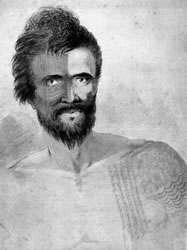 |
|
Asymmetrical tattooing of a Hawaiian man
observed
by the Cook expedition, 1778.
|
When the first references to Hawaiian tattoo appeared in the logs of Cook's voyage of 1778-79, the vast majority of observed designs were both geometrical and asymmetrical in nature. Moreover, it was noted that tattooing was not as common as that found in Tahiti nor did anyone recollect "to have seen any man whose business it was to tattoo others" or even tattooing tools themselves. This evidence, combined with the general lack of archaeological evidence of pre-contact tattooing tools, may suggest that the custom of Hawaiian tattoo may have been more kapu (the Hawaiian word for tapu) than in other Polynesian societies, and that tattooing tools were discarded or destroyed after being used. Whatever the circumstance, by the 1830s the practice was by "now almost obsolete."
As compared to the rest of Polynesia, the culture of Hawaiian tattooing seemed to be disintegrating around the time of Cook's arrival. Western motifs including guns, goats, and other objects had appeared and were gradually supplanting traditional abstract designs. This movement in style was perhaps due to a political shift in traditional patterns of rule whereby the old school of heavily tattooed chiefs of godly genealogical descent of the highest grade (kapu more) were gradually being supplanted by more "modern" men of lower pedigree and grade (kapu wohi) like Kamehameha, who through sheer guile and political strategy eventually unified the entire archipelago from his base on the island of Hawaii.
In the late eighteenth-century, however, vestiges of the traditional art of Hawaiian tattooing were still to be seen. These traces were typically observed on islands of the "old order" like Maui where the chiefdom was considered to be one of most ancient. Headed by a powerful and profusely tattooed warrior king Kahekili, Maui was a far cry from Kamehameha's Hawaii where developed feudalism, not ancestry, was the tool with which he eventually governed the people.
| |
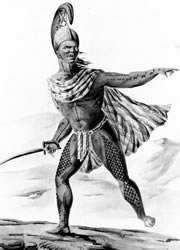 |
|
Symmetrical tattooing of a revered
Hawaiian military officer, 1819.
|
Kahekili was a direct descendant of the thunder-god Kanehekili. In his image, he was tattooed solid black on the right side of his body, a form called pahupahu, as were his warrior chiefs and household companions. Oral history relates that everyone knew Kahekili was a man who possessed great mana. "He could speak to the thunder and lightning, and they avenged him instantly upon his enemies; those persons who cursed him and abused him were all killed suddenly by thunder and lighting. His enemies therefore plotted in their hearts to kill him and whispered about it in secret. While they whispered, thunder struck. His enemies ceased to plot and to think evil thoughts."
Kahekili's asymmetrical tattooing, or that which appeared on the right side of the body, was also significant in other symbolic respects. In Polynesian thought, the right side of the body is the male side: the strong and lucky side. It also stood for vigor, health, virility, and life. Moreover, both sides of Kahekili's head were tattooed with half-circles or crescent arches called hoaka. Interestingly, early Hawaiian drums called pahu (meaning a drum, box, or container) were often decorated with similar arches called hoaka and they may have symbolized conjoined anthropomorphs that traced both lineal and collateral genealogical relationships back to the gods. By symbolic implication, then, Kahekili was not only wrapped in a virtual cloak of tattooed ancestry; he was encapsulated in a body of sacred protection.
| |
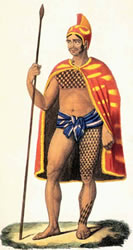 |
|
Tattooing of a Hawaiian chief, 1819.
|
Kahekili's warriors also attempted to harness their leader's protective potential through similar forms of tattooing, because these powerful and divine genealogical markers were, as noted, imbued with great mana. However, other writers have argued that such asymmetrical tattooing was necessary because it protected those vulnerable parts of the body that were exposed during battle. For example, warrior chiefs and their soldiers often wore capes of feathers or other materials to shield their backs from the weapons of their enemies. Helmets safeguarded their heads but when a warrior prepared to hurl a spear or brandish his club, one side of his body became susceptible to his adversaries. This assertion seems to make good sense, but Hawaiian warriors did employ shields when they wielded their weapons and several early illustrations also show men with their tattooed sides covered by their cloaks. Other images show warrior tattooing appearing on the same side of the body that was employed to launch a weapons. Therefore, perhaps it was the weapon-bearing side of the body that needed the most protection.
Of course, and as in the Marquesas, inhabitants of one Hawaiian valley may have adhered to a slightly different custom of tattooing than their neighbors because they found a more appropriate or effective solution. Furthermore, while certain tattooing patterns found across the islands may have looked similar, it is quite probable that the names varied from island to island, and valley to valley, as they did between individual tattoo masters or kahuna ka kakau.
Kahuna and Hawaiian Tattooing Designs
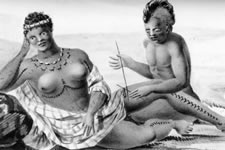 |
|
Hawaiian tattooing scene, 1819.
|
Although little is known regarding the life, work, and ritual practices of the kahuna of old, they were certainly revered for their highly skilled work, creativity, and knowledge of natural substances suitable for tattooing. For example,kahuna fashioned tattooing combs (moli) out of the wing bones of the albatross (also called moli). This material was preferred because it was slightly flexible and the teeth would rarely break off after puncturing the skin. The comb was attached to a handle manufactured from the midrib of a coconut frond, and was hand-tapped into the skin with the aid of a small but heavy mallet of wood.
Tattooing pigment was derived from a suite of various natural sources, but the soot from the burnt Kukui nut (candlenut) was perhaps the most popular. Other accounts report that some tattooists mixed the juice of the Hawaiian pokeberry with the pulverized fruits of a local iris called mauulaili (Sisyrinchium acre) to create their inks, whereas the gall of a certain shellfish or juice from the roots of Plumbago zenlanica (a kind of small evergreen shrub) were also used.
Before more Western elements began to pervade the artistic cannons of kahuna towards the beginning of the nineteenth-century, highly geometric patterns consisting of various configurations of angled arches, zigzags, checkerboards, stacked chevrons, and triangles were applied to the body. The vast majority of these patterns invoked the backbone or spine which was a visible metaphor for genealogical descent; since, the spine stood for a series of lineage members linked through a common line of descent.
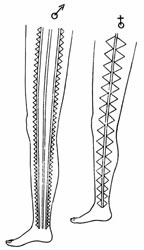 |
|
Kauai leg tattooing, ca. 1900.
|
Notwithstanding it is thought that when a kahuna operated, he chanted sacred prayers infused with mana as he laid down his designs. Such actions would have been particularly important when preparing a warrior for battle, for it is believed that such men were blackened with tattooing in anticipation of specific military engagements. Similar protective chants were uttered when the feathered cloaks of warriors and other high ranking individuals were constructed. This practice was understood to capture the supernatural energy embodied in the esoteric words in an attempt to contain them within the sacred mantel of the encapsulating cloak.
Other forms of tattooing recalled the presence of deified ancestors ('aumakua) of personal and collective protection, and acted as a conduit through which these spiritual entities traveled to enter the world of their living descendants. Oftentimes, these designs took on specific patterns, like a series of arches, sharks teeth (niho mano), or other natural elements that can be likened to a family crest. But in other cases, 'aumakua tattoos represented a specific animal that was identified with a particular ancestor.
For some Hawaiian families sharks were considered to be an ancestral 'aumakua, and the Hawaiian historian Samuel Kamakau captured many of these native traditions in the late nineteenth-century. For example, most of the sharks that had become supernatural beings were originally people that received their shark forms from the gods. But these ancestral spirits did not show themselves in all sharks, because only those who had been given distinguishing marks were considered to be sacred. Of course, these visual characteristics were made known to their human descendants through the assistance of the family's kahu (a kind of physical, educational, and spiritual caretaker), who was usually a relative, and their offspring.
Thus, if a family member were in trouble and in danger of death on the ocean, they would call upon their shark 'aumakua, and that shark would render its assistance so that the individual would escape death. Hawaiians are very familiar with these events, and it is said that shark 'aumakua could save as many as ten to forty individuals at one time.
A related story recorded in the 1920s stated that a woman was seen wearing a row of dots tattooed around her ankle as a "charm" against sharks. The backstory to this account, however, related that she was in fact bitten by a shark, which was her "guardian god" or 'aumakua. This shark, which the woman recognized, had seized her ankle while she was swimming. When she cried out his name, he released her and proclaimed, "I will not make that mistake again, for I will see the marks on your ankle."
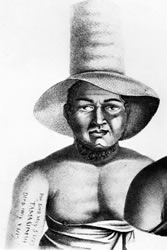 |
|
Mortuary tattooing, 1819.
|
Sometimes a kahuna hand-tapped a series of small dots to signify or accompany a particular 'aumakua design. These patterns usually symbolized the eyes of the ancestral 'aumakua and offered their protection through reference to their supernatural vision.
In Hawaii, tattoos also commemorated the death of beloved chiefs and other notable figures in society. These marks of mourning not only served to show allegiance to the departed, but perhaps expressed an individual's desire to experience death through an act of self-mutilation. Tattoos of this sort usually took the form of the deceased's name tattooed on a forearm or other body part, but in extreme cases the wives of the dead also had their tongues subjected to the painful taps of the kahuna's moli: many mourners also knocked out one or more of their teeth. Whether this act of tattooing had a protective function is not known, but it can be implied that the skin became stronger with these added layers of sacrificial meaning.
Next Page | 1 | 2 | 3 | 4 | 5 | 6 | 7 | 8 |
Museum photo gallery of the images
on this page may be seen here. |






